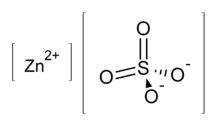
| |

| |
| Names | |
|---|---|
| IUPAC name
Zinc sulfate
| |
| Other names
White vitriol
Goslarite | |
| Identifiers | |
| |
3D model (JSmol)
|
|
| ChEBI | |
| ChEMBL | |
| ChemSpider | |
| DrugBank | |
| ECHA InfoCard | 100.028.904 |
| EC Number |
|
| KEGG | |
PubChem CID
|
|
| RTECS number |
|
| UNII |
|
| UN number | 3077 |
CompTox Dashboard (EPA)
|
|
| |
| |
| Properties | |
| ZnSO4 | |
| Molar mass | 161.44[1] g/mol (anhydrous) 179.47 g/mol (monohydrate) 287.53 g/mol (heptahydrate) |
| Appearance | white powder |
| Odor | odorless |
| Density | 3.54 g/cm3 (anhydrous) 2.072 g/cm3 (hexahydrate) |
| Melting point | 680 °C (1,256 °F; 953 K) decomposes (anhydrous) 100 °C (heptahydrate) 70 °C, decomposes (hexahydrate) |
| Boiling point | 740 °C (1,360 °F; 1,010 K) (anhydrous) 280 °C, decomposes (heptahydrate) |
| 57.7 g/100 mL, anhydrous (20 °C) (In aqueous solutions with a pH < 5)[2] | |
| Solubility | alcohols |
| −45.0·10−6 cm3/mol | |
Refractive index (nD)
|
1.658 (anhydrous), 1.4357 (heptahydrate) |
| Thermochemistry | |
Std molar
entropy (S⦵298) |
120 J·mol−1·K−1[3] |
Std enthalpy of
formation (ΔfH⦵298) |
−983 kJ·mol−1[3] |
| Hazards | |
| GHS labelling: | |
  
| |
| Danger | |
| H302, H318, H410 | |
| P264, P270, P273, P280, P301+P312, P305+P351+P338, P310, P330, P391, P501 | |
| NFPA 704 (fire diamond) | |
| Flash point | Non-flammable |
| Safety data sheet (SDS) | ICSC 1698 |
| Related compounds | |
Other cations
|
Cadmium sulfate Manganese sulfate |
Related compounds
|
Copper(II) sulfate |
Except where otherwise noted, data are given for materials in their standard state (at 25 °C [77 °F], 100 kPa).
| |
Zinc sulfate describes a family of inorganic compounds with the formula ZnSO4(H2O)x. All are colorless solids. The most common form includes water of crystallization as the heptahydrate,[4] with the formula ZnSO4·7H2O. As early as the 16th century it was prepared on the large scale, and was historically known as "white vitriol"[5] (the name was used, for example, in 1620s by the collective writing under the pseudonym of Basil Valentine)[citation needed]. Zinc sulfate and its hydrates are colourless solids.
- ^ "Zinc sulphate".
- ^ Lide, David R., ed. (2006). CRC Handbook of Chemistry and Physics (87th ed.). Boca Raton, FL: CRC Press. ISBN 0-8493-0487-3.
- ^ a b Zumdahl, Steven S. (2009). Chemical Principles 6th Ed. Houghton Mifflin Company. p. A23. ISBN 978-0-618-94690-7.
- ^ Cite error: The named reference
ulmannswas invoked but never defined (see the help page). - ^ Roscoe, Henry Enfield; Schorlemmer, Carl (1889). A Treatise on Chemistry: Metals. Appleton.
